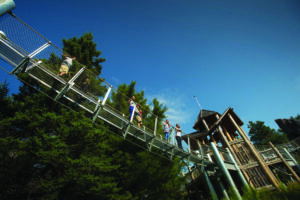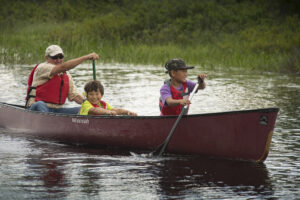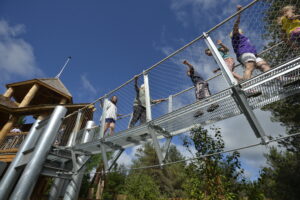I pack my swimsuit, sunscreen, hiking shoes, and notebook as soon as the Wild Center invites (585) for an in-depth visit to the museum. I will need them all.
The drive to the Adirondacks from Rochester is beautiful as always. Open fields turn to shale cliffs turn to seas of pine as we travel eastward through the state. The folks at the Wild Center recommend we stay at the Saranac Inn, thirty minutes from the museum. We aren’t disappointed—our spacious suite overlooks the lake, and the cozy modern built-in restaurant—the Campfire Grill & Bar—leaves us stuffed and still wanting s’more (sorry).
As we pull into the parking lot (the entrance of which we passed a couple times), we meet Clifford Hart, long-time consultant and our on-again, off-again tour guide throughout the day. The Wild Center was founded in 2006 with a pretty straightforward platform, according to Hart: “Be approachable. Don’t make science hard to understand.” After one step into the building, I already see they’ve succeeded. An ice age exhibit beckons me to touch a glacier, samples show visitors which flora grows at different altitudes, live otters play in a large tank, and no one tells me I’m too old to crawl in the tunnel and see them up close. We visit during the fiftieth anniversary of the moon landing, and a special set is outfitted like a ’60s living room for photo ops. All in all, the exhibit loop inside the building brilliantly takes visitors chronologically from the dawn-of-time Adirondacks through today.
Stephanie Ratcliffe, the museum’s executive director, has been on board from the start. After many successful years at the Smithsonian and Maryland Science Center, Ratcliffe was drawn to the Wild Center’s mission. “Obviously the notion of starting a museum was really exciting, but I was really trying to go very deep and look at the stories of a particular place,” she says. While the Wild Center puts the Adirondacks under a microscope, there’s a universality she couldn’t ignore. “What we worked hard on and are really aware of, is that people come here from all over the US and even the world. While we’re telling the story of the Adirondacks, we’re also giving ideas that they can take home to their backyards. For example,” she explains, “we might talk about what otters are about in the Adirondacks, and we can talk about how they live in other parts of North America. We always try and take a story and talk about it in a particular way to make information relevant in their backyard.”
One opportunity for visitors is a guided kayak trip down the Oxbow River, where we learn about more aquatic life and some of the region’s history of deforestation. Between the sounds of buzzing horseflies (wear DEET!) and beaver tailslaps, our guide explains that the town of Tupper Lake had its heyday as a mill town in the early-to-mid twentieth century, where restaurants, bars, and hotels thrived by serving loggers. As it became more profitable for corporations to source lumber from other countries, Tupper was left with a gap in its economy—and a choice on how to move forward. “Logging is still alive and well and is part of the economy today,” Ratcliffe later explains. “A lot of people visit and see a logging truck and say, ‘what a surprise!’ But it’s still very much part of our economy.” However, modern logging follows heavy regulation—through activism and engagement within the most conservation-minded community Ratcliffe’s ever seen. “I vacationed here many years without understanding the bigger story,” she says, “but people here really understand a balance between man and nature.” She describes it as a diverse democracy, where folks are actively engaged in local politics with an intense passion for the world around them. “When you go into a coffee shop, everyone has an opinion,” she says. “And people are more aware than any other place I’ve lived about having these environmental conversations. So, long story short,” she summarizes, “here’s the story of the Adirondacks: logging was here, there was a period of overlogging, more regulation came into play, and now there is a constant conversation about it:‘Is this the balance we want to achieve?’”
Through its programs, the Wild Center aims to spark those questions in visitors. “So if we bring out a porcupine, you can meet them, and they’re adorable. But you’ll also learn there was a time when people thought they were a nuisance species and wanted to get rid of them. We are educating people about the animal so maybe that doesn’t happen again,” she says. “Nature fixes itself.”
Ratcliffe sees the Adirondack region as a precursor for the rest of the planet—an ecological transformation, and one long overdue. “A hundred years ago some visionaries created the park, and nature has greatly recovered. We have this 100-year-old experiment and an example for this model. People come from around the world to study this model and see how it works.” In many ways, the Wild Center itself is an indicator of nature’s capacity for regeneration. Despite the dense forestation and thriving ecosystem, the site used to be farmland. “These are really only sixty-year-old concessional forests, where cattle grazed at one time,” says Ratcliffe. “The forest was changed to recover pastureland.” The south end of the building is set into Greenleaf Pond, a manmade body of water created after the main building was complete. Floor-to-ceiling windows in the café and great hall offer visitors an aquarium-esque look into the ecosystems now at work in the depths of the pond. “We created that habitat,” Ratcliffe stresses. “We have photos from when it was completely farmland. Given the chance, nature can recover.”
One of the best ways to appreciate how far the region has come is the Wild Walk—one of the Wild Center’s main attractions. Wooden bridges ascend into the treetops, offering a unique perspective on the region and life within it. As our footsteps transition from soft forest floor to the planked bridges of this unique exhibit, the guide explains that the structure rises at a very mild gradient in an effort to make it accessible to nearly all visitors. Without breaking a sweat, we climb through different ecosystems of the Adirondack forest. Eventually we reach the Snag, an artificial (but still very cool) four-story white pine stump. With a winding stairwell and miniature exhibits inside, visitors are able to explore this larger-than-life recreation as if we were the very critters we learn about from the plaques, display cases, and museum staff giving demonstrations and ready to answer questions.
The Snag isn’t our only opportunity to experience life as a small inhabitant of the Adirondacks. A trampoline-like spider web gives visitors the opportunity to see how it feels for spiders to walk along their webs—and an idea of the vibrations that alert them when they’ve captured a meal. We also get to climb into a recreated bald eagle’s nest—the highest point on the Wild Walk—to take in the miles-in-every-direction view these raptors experience every day.
Still, my favorite aspect of the Wild Walk might be the mounted binoculars that are fixed onto labeled mountains in the distance. Some I’ve summited; others are on my to-do list. In many ways, the Wild Walk epitomizes the Wild Center’s message, which is easier to show than tell—simply to highlight how miniscule yet great we all are, and how wonderfully individual yet interconnected the lives we live.
One of the Wild Center’s most interesting initiatives is one they never planned. “Back in 2008 we held a climate change summit, mainly for industry folks and political leaders,” explains marketing manager Nick Gunn. Out of that meeting, a local high school student asked what young people can do to help. “The following year we held the first youth climate summit, a two-day event where the first day they hold workshops and attend talks by industry experts, second day they devise climate action plans, things in their own community.” Since then, the Wild Center’s Youth Climate Program has attended more than thirty summits around the world, including Sri Lanka, Finland, Liberia, and Munich. “So, while you may not see its presence in the museum, it is a large piece of work that the Wild Center does,” says Gunn. The program has also branched into several other cities within the US.
Ratcliffe sees this program continuing to grow as the planet grapples more and more with the consequences of climate change. “We’re looking at the solutions already utilized here in the Adirondacks; whether it’s farming methods or solar projects or, in our case, heat or compost. All these different strategies about climate change.” While it’s easy to feel forlorn about climate change, she says, the Wild Center is staying positive. “It’s going to be hopeful, and it’s really going to focus on the solution,” she says.
Much like researchers have visited from around the globe to learn about the Adirondacks’ model of rebounding nature, Ratcliffe hopes to serve as a transition hub throughout the upcoming decades. “I want to be the place people can come to and rely on,” she says. “That means we’re going to have to keep up on policy change and stay informed so we can be the go-to place people can count on.” As a result of the overwhelming global interest in their Youth Climate Program, the Wild Center created a toolkit available on their website for anybody who wants to host their own summit. “In the future there will be webinars, and we’ll continue working with contractors and builders, finding speakers, and holding workshops to teach and learn about the latest products and techniques in green building and design.”
I ask Ratcliffe if she wants to add anything before we end our interview. “Sometimes it’s through art; sometimes it’s to see an otter swim and look at them eye to eye. Even if it’s for just a few minutes that you’re making this brief connection with nature, that’s what we do uniquely here,” Ratcliffe says. “That’s the stuff that people remember and the stuff that stays with them. That’s the motivation of wanting to do better by people, and that’s the kind of motivation that only comes from each other.” Wildcenter.org
John Ernst is a passionate writer, hiker, and gamer born and raised in Rochester. Johnmwrites.com
Views: 0








